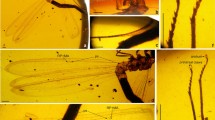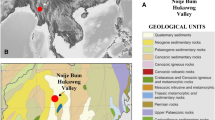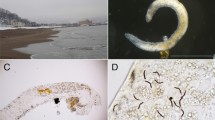Abstract
Spiders (Araneae) are a hugely successful lineage with a long history. Details of their origins remain obscure, with little knowledge of their stem group and few insights into the sequence of character acquisition during spider evolution. Here, we describe Chimerarachne yingi gen. et sp. nov., a remarkable arachnid from the mid-Cretaceous (approximately 100 million years ago) Burmese amber of Myanmar, which documents a key transition stage in spider evolution. Like uraraneids, the two fossils available retain a segmented opisthosoma bearing a whip-like telson, but also preserve two traditional synapomorphies for Araneae: a male pedipalp modified for sperm transfer and well-defined spinnerets resembling those of modern mesothele spiders. This unique character combination resolves C. yingi within a clade including both Araneae and Uraraneida; however, its exact position relative to these orders is sensitive to different parameters of our phylogenetic analysis. Our new fossil most likely represents the earliest branch of the Araneae, and implies that there was a lineage of tailed spiders that presumably originated in the Palaeozoic and survived at least into the Cretaceous of Southeast Asia.
This is a preview of subscription content, access via your institution
Access options
Access Nature and 54 other Nature Portfolio journals
Get Nature+, our best-value online-access subscription
$29.99 / 30 days
cancel any time
Subscribe to this journal
Receive 12 digital issues and online access to articles
$119.00 per year
only $9.92 per issue
Buy this article
- Purchase on Springer Link
- Instant access to full article PDF
Prices may be subject to local taxes which are calculated during checkout






Similar content being viewed by others
References
Selden, P. A. Fossil mesothele spiders. Nature 379, 498–499 (1996).
Selden, P. A., Shcherbakov, D. E., Dunlop, J. A. & Eskov, K. Y. Arachnids from the Carboniferous of Russia and Ukraine, and the Permian of Kazakhstan. Paläont. Z. 88, 297–307 (2014).
Shear, W. A., Palmer, J. M., Coddington, J. A. & Bonamo, P. M. A Devonian spinneret: early evidence of spiders and silk use. Science 246, 479–481 (1989).
Selden, P. A., Shear, W. A. & Bonamo, P. M. A spider and other arachnids from the Devonian of New York, and reinterpretations of Devonian Araneae. Palaeontology 34, 241–281 (1991).
Selden, P. A., Shear, W. A. & Sutton, M. D. Fossil evidence for the origin of spider spinnerets, and a proposed arachnid order. Proc. Natl. Acad. Sci. USA 105, 20781–20785 (2008).
Platnick, N. I. & Gertsch, W. J. The suborders of spiders: a cladistics analysis. Am. Mus. Novit. 2607, 1–15 (1976).
Haupt, J. The Mesothelae—a monograph of an exceptional group of spiders (Araneae: Mesothelae). Zoologica 154, 1–102 (2003).
Shultz, J. W. A phylogenetic analysis of the arachnid orders based on morphological characters. Zool. J. Linn. Soc. 150, 221–265 (2007).
Savory, T. On the arachnid order Palpigradi. J. Arachnol. 2, 43–45 (1974).
Legg, D. A., Sutton, M. D. & Edgecombe, G. D. Arthropod fossil data increase congruence of morphological and molecular phylogenies. Nat. Commun. 4, 2485 (2013).
Garwood, R. J. & Dunlop, J. A. Three-dimensional reconstruction and the phylogeny of extinct chelicerate orders. PeerJ 2, e641 (2014).
Garwood, R. J. et al. Almost a spider: a 305-million-year-old fossil arachnid and spider origins. Proc. R. Soc. B 283, 20160125 (2016).
Lamarck, J. B. Système des Animaux sans Vertebres (Deterville, Paris, 1801).
Wunderlich, J. New and rare fossil spiders (Araneae) in mid Cretaceous amber from Myanmar (Burma), including the description of new extinct families of the suborders Mesothelae and Opisthothelae as well as notes on the taxonomy, the evolution and the biogeography of the Mesothelae. Beitr. Araneol. 10, 72–279 (2017).
Selden, P. A. & Ren, D. A review of Burmese amber arachnids. J. Arachnol. 45, 324–343 (2017).
Miether, S. T. & Dunlop, J. A. Lateral eye evolution in the arachnids. Arachnology 17, 103–119 (2016).
Wheeler, W. C. et al. The spider tree of life: phylogeny of Araneae based on target-gene analyses from an extensive taxon sampling. Cladistics 33, 574–616 (2017).
Raven, R. J. The spider infraorder Mygalomorphae (Araneae): cladistics and systematics. Bull. Am. Mus. Nat. Hist. 182, 1–180 (1985).
Kraus, O. Liphistius and the evolution of spider genitalia. Symp. Zool. Soc. Lond. 42, 235–254 (1978).
Shultz, J. W. The origin of the spinning apparatus in spiders. Biol. Rev. 62, 89–113 (1987).
Marples, B. J. The spinnerets and epiandrous glands of spiders. J. Linn. Soc. Zool. 46, 209–222 (1967).
Sharma, P. P. Chelicerates and the conquest of land: a view of arachnid origins through an evo-devo spyglass. Int. Comp. Biol. 57, 510–522 (2017).
Dunlop, J. A. & Lamsdell, J. C. Segmentation and tagmosis in Chelicerata. Arth. Struct. Dev. 46, 395–418 (2017).
O’Reilly, J. E. et al. Bayesian methods outperform parsimony but at the expense of precision in the estimation of phylogeny from discrete morphological data. Biol. Lett. 12, 20160081 (2016).
Shi, G. H. et al. Age constraint on Burmese amber based on U–Pb dating of zircons. Cretac. Res. 37, 155–163 (2012).
Ross, A., Mellish, C., York, P. & Crighton, B. in Biodiversity of Fossils in Amber from the Major World Deposits (ed. Penney, D.) 208–235 (Siri Scientific Press, Manchester, 2010).
Wang, B. et al. Debris-carrying camouflage among diverse lineages of Cretaceous insects. Sci. Adv. 2, e1501918 (2016).
Garwood, R. J., Dunlop, J. A., Knecht, B. J. & Hegna, T. A. The phylogeny of fossil whip spiders. BMC Evol. Biol. 17, 105 (2017).
Acknowledgements
We are grateful to M. Engel and J. Wunderlich for helpful initial comments, Y. Huang and Y. Ying for providing specimens, Z. Yin and S. Wu for the micro-computed tomography reconstruction, J. Keating for advice on Bayesian inference of phylogeny and D. Yang for the reconstruction. This research was supported by the National Natural Science Foundation of China (41572010, 41622201 and 41688103), the Chinese Academy of Sciences (XDPB05) and the Youth Innovation Promotion Association of the Chinese Academy of Sciences (number 2011224).
Author information
Authors and Affiliations
Contributions
B.W. designed the project. B.W., J.A.D., P.A.S., R.J.G. and W.A.S. all contributed to observation and interpretation of the fossils and drafted the manuscript. B.W. and X.L. produced the photographs. P.A.S. produced the line drawings, measurements and description. R.J.G. ran the phylogenetic analysis. P.M. collected data.
Corresponding author
Ethics declarations
Competing interests
The authors declare no competing financial interests.
Additional information
Publisher’s note: Springer Nature remains neutral with regard to jurisdictional claims inpublished maps and institutional affiliations.
Supplementary information
Supplementary Information
Supplementary figures, phylogenetic reconstruction and character list
Supplementary Data
Executable data matrices
Supplementary Video
3D reconstruction of specimen NIGP166871
Rights and permissions
About this article
Cite this article
Wang, B., Dunlop, J.A., Selden, P.A. et al. Cretaceous arachnid Chimerarachne yingi gen. et sp. nov. illuminates spider origins. Nat Ecol Evol 2, 614–622 (2018). https://doi.org/10.1038/s41559-017-0449-3
Received:
Accepted:
Published:
Issue Date:
DOI: https://doi.org/10.1038/s41559-017-0449-3
This article is cited by
-
Single-cell transcriptomics reveals the brain evolution of web-building spiders
Nature Ecology & Evolution (2023)
-
The first Palaeozoic spider (Arachnida: Araneae) from Germany
PalZ (2023)
-
Exites in Cambrian arthropods and homology of arthropod limb branches
Nature Communications (2021)
-
Morphological changes during the post-embryonic ontogeny of mesothelan spiders and aspects of character evolution in early spiders
Development Genes and Evolution (2021)
-
Developmental gene expression as a phylogenetic data class: support for the monophyly of Arachnopulmonata
Development Genes and Evolution (2020)



